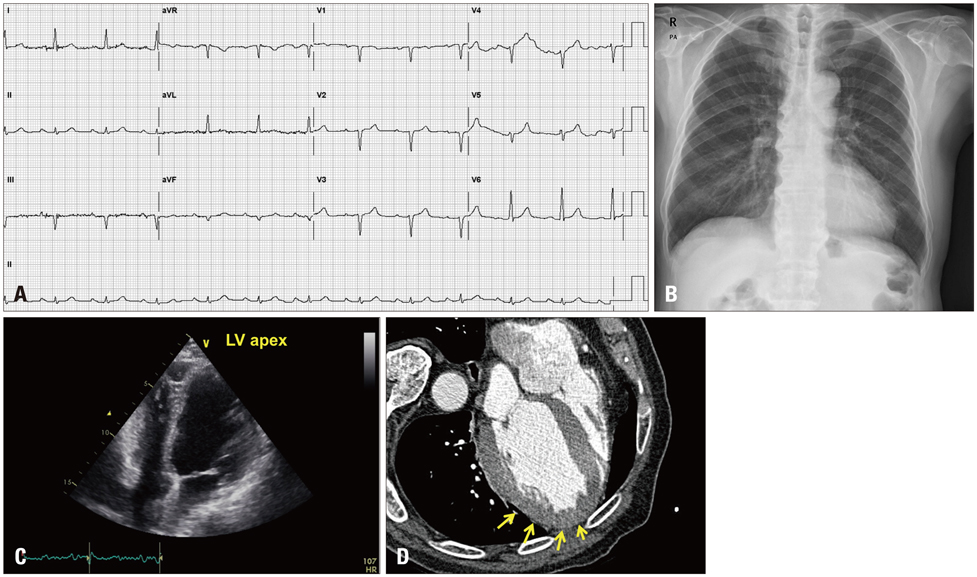J Cardiovasc Ultrasound.
2014 Mar;22(1):36-39. 10.4250/jcu.2014.22.1.36.
Congenital Absence of the Pericardium
- Affiliations
-
- 1Cardiovascular Center, Seoul National University Bundang Hospital, Seongnam, Korea. flammeus1@gmail.com
- 2Department of Internal Medicine, Seoul National University College of Medicine, Seoul, Korea.
- 3Department of Radiology, Seoul National University Bundang Hospital, Seongnam, Korea.
- KMID: 2177455
- DOI: http://doi.org/10.4250/jcu.2014.22.1.36
Abstract
- Congenital absence of the pericardium is a rare cardiac malformation and is most often asymptomatic. It is usually discovered as an incidental finding. Physical examination, chest radiography, and electrocardiogram are often unremarkable. Echocardiography provides valuable information, and sometimes computed tomography or magnetic resonance imaging is needed for subsequent confirmation.
MeSH Terms
Figure
Reference
-
1. Abbas AE, Appleton CP, Liu PT, Sweeney JP. Congenital absence of the pericardium: case presentation and review of literature. Int J Cardiol. 2005; 98:21–25.
Article2. Centola M, Longo M, De Marco F, Cremonesi G, Marconi M, Danzi GB. Does echocardiography play a role in the clinical diagnosis of congenital absence of pericardium? A case presentation and a systematic review. J Cardiovasc Med (Hagerstown). 2009; 10:687–692.
Article3. D'Altorio R, Cano JY. Congenital abscence of the left pericardium detected by imaging of the lung: case report. J Nucl Med. 1977; 18:267–268.4. Eyileten Z, Arikbuka M, Yazicioğlu L, Ozyurda U. Left pericardial agenesis in a patient with sinus venosus type atrial septal defect. Anadolu Kardiyol Derg. 2007; 7:205–206.5. Lu C, Ridker PM. Echocardiographic diagnosis of congenital absence of the pericardium in a patient with VATER association defects. Clin Cardiol. 1994; 17:503–504.
Article6. Zakowski MF, Wright Y, Ricci A Jr. Pericardial agenesis and focal aplasia cutis in tetrasomy 12p (Pallister-Killian syndrome). Am J Med Genet. 1992; 42:323–325.
Article7. Boscherini B, Galasso C, Bitti ML. Abnormal face, congenital absence of the left pericardium, mental retardation, and growth hormone deficiency. Am J Med Genet. 1994; 49:111–113.
Article8. Sivrikoz MC, Durceylan E, Boztepe H, Birdane A. Congenital total absence of pericardium in a patient with left lung lower lobe bronchiectasis. Anadolu Kardiyol Derg. 2011; 11:81–83.
Article9. Lau KW, Ding ZP. Images in cardiovascular medicine. Partial pericardial defect. Circulation. 1998; 97:1992.10. Faridah Y, Julsrud PR. Congenital absence of pericardium revisited. Int J Cardiovasc Imaging. 2002; 18:67–73.11. Hoey ET, Yap KS, Darby MJ, Mankad K, Puppala S, Sivananthan MU. Complete left pericardial defect: evaluation with supine and decubitus dual source CT. J Cardiovasc Comput Tomogr. 2009; 3:417–419.
Article12. Hotouras A, Shahin Y. Pericardial agenesis: a rare cause of chest pain. Postgrad Med J. 2010; 86:380–381.
Article13. Gatzoulis MA, Munk MD, Merchant N, Van Arsdell GS, McCrindle BW, Webb GD. Isolated congenital absence of the pericardium: clinical presentation, diagnosis, and management. Ann Thorac Surg. 2000; 69:1209–1215.
Article
- Full Text Links
- Actions
-
Cited
- CITED
-
- Close
- Share
- Similar articles
-
- Congenital Complete Left-Sided Absence of the Pericardium Incidentally Identified in the Autopsy: A Case Report
- Incidentally Detected Pericardial Defect in a Patient with Pneumothorax as Confirmed on Video-Assisted Thoracoscopic Surgery
- Indentation in the Right Ventricle by an Incomplete Pericardium on 3-Dimensional Reconstructed Computed Tomography
- A Case of Congenital Pericardial Defect
- Congenital Left Atrial Appendage Aneurysm: A Case Report




